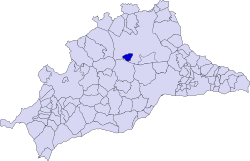Valle de Abdalajís
| Valle de Abdalajís | |||
|---|---|---|---|
| Municipality | |||
|
|||
 |
|||
| Location in Spain | |||
| Coordinates: 36°56′N 4°41′W / 36.933°N 4.683°W | |||
| Country |
|
||
| Autonomous community |
|
||
| Province | Málaga | ||
| Government | |||
| • Alcalde | Alonso García Carrasco (PSOE) | ||
| Area | |||
| • Total | 21 km2 (8 sq mi) | ||
| Elevation | 358 m (1,175 ft) | ||
| Population (2009) | |||
| • Total | 2,842 | ||
| • Density | 140/km2 (350/sq mi) | ||
| Demonym(s) | Vallestero, Valluno | ||
| Time zone | CET (UTC+1) | ||
| • Summer (DST) | CEST (UTC+2) | ||
| Postal code | 29240 | ||
| Dialing code | 95 | ||
| Official language(s) | Spanish | ||
| Website | Official website | ||
Valle de Abdalajís is a town and municipality in the province of Málaga, part of the autonomous community of Andalucía in southern Spain. It is located in the comarca of Antequera. The municipality is situated approximately 50 kilometres from the provincial capital of Málaga. It has a population of approximately 3,000 residents. The natives are called Vallesteros or Vallunos.
The village is in the heart of the Penibetica mountain ranges and it's at the foot of the Abdalajís mountain range. The municipality is one of the smallest, in terms of area, in the province of Málaga. It has 21.4 km². It belongs to the Valle del Guadalhorce region.
Valle de Abdalajís is near to Antequera (21 km), Álora and the city of Málaga (50 km).
The vegetation of this county is typical of a Mediterranean mountain town, abounding in low brush scrub and xerophytic vegetation due to dry and hot weather. Furthermore, the rockiness of the mountains and the fate of the lands to the cultivation of almond, grain and olive trees, the forests are absent.
In the mountains gives predominantly the typical vegetation of Mediterranean limestone areas characterized by low scrub (thyme, rosemary, lavender, gorse, prickly pears, agaves, palms, rock roses, hawthorn and broom), plus a number lower plant as evergreens, vincas, St John's Wort, poppies, peonies, lilies, some types of orchids Mediterranean ... In the margins of the stream (The Arroyo de las piedras stream) are numerous species of vegetation of Mediterranean coastline and promenade, such as blackberries, rushes and sedges, Oleander, water lily, watercress, matagallos, ivy, ... However, the riparian woody vegetation has completely disappeared due to cultivation of the fields adjacent to the stream.
...
Wikipedia



